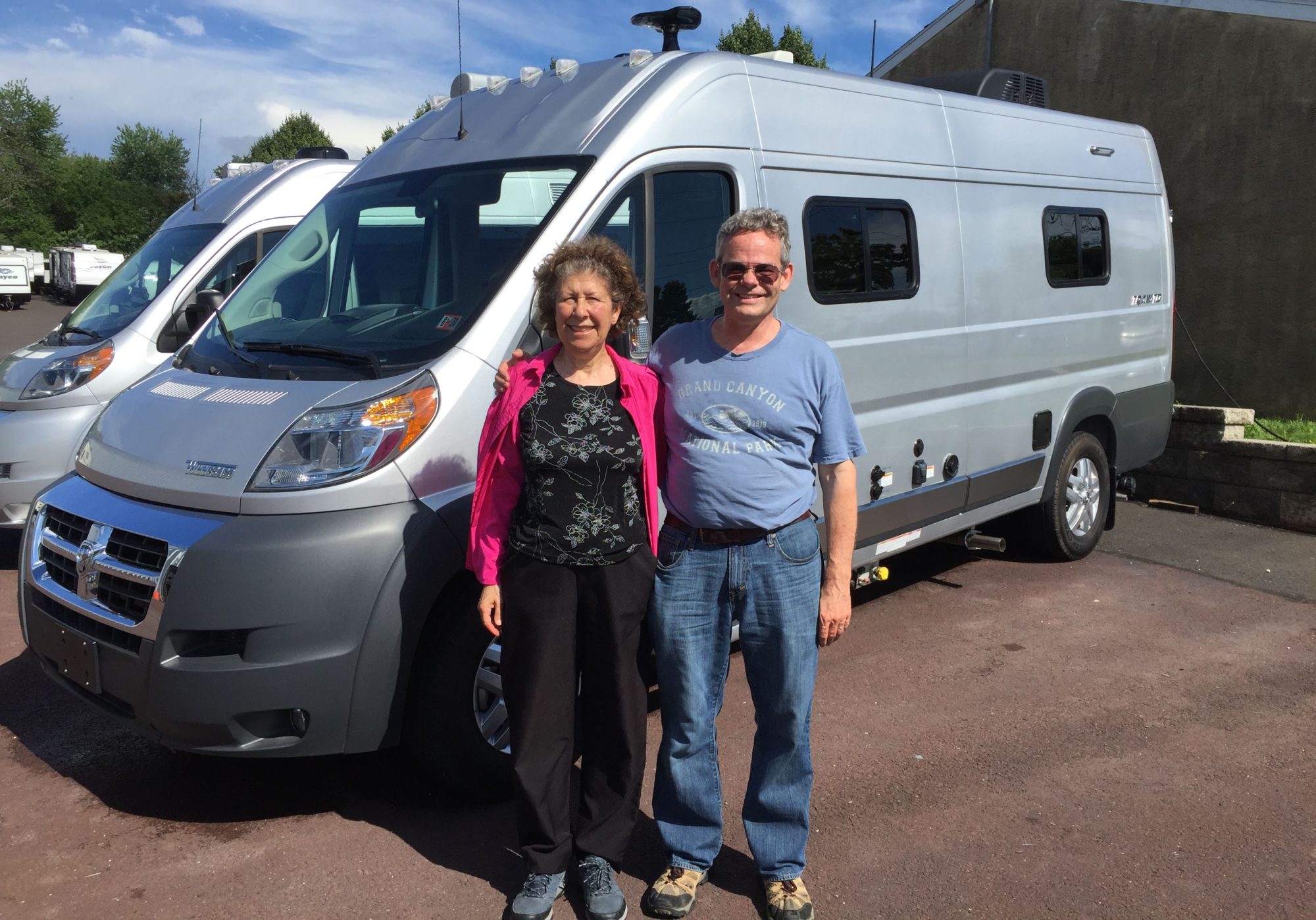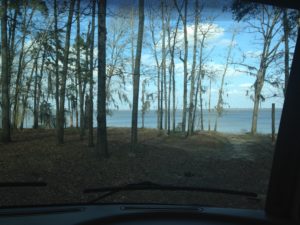 Feb. 13: After leaving Columbia, we decided to spend a few days doing more “wilderness” activities and headed for Santee State Park on Lake Marion, SC. Like many of the lakes in SC, this is a man-made lake, with a highly crenellated shore. It is really quite lovely, as you can see from the view from our window. It was also lovely at sunrise (and no thanks to Rumple for getting me out of bed that early).
Feb. 13: After leaving Columbia, we decided to spend a few days doing more “wilderness” activities and headed for Santee State Park on Lake Marion, SC. Like many of the lakes in SC, this is a man-made lake, with a highly crenellated shore. It is really quite lovely, as you can see from the view from our window. It was also lovely at sunrise (and no thanks to Rumple for getting me out of bed that early).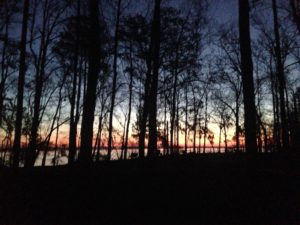
So far, we have tried to park close to major highways, because the RV is rather unwieldly, especially when towing the car. But although the Santee State Park is not far from I95, there was a fairly long haul on smaller roads. As a result, we got to try out an untested piece of RV equipment – our roof ladder.
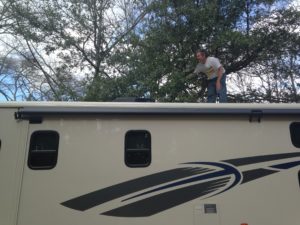 The RV is 12 ft high. It also has a number of items on the roof, including the TV antenna, air conditioner and fan vent openings. It can be a bit difficult to remember this when driving. Smaller roads have trees closer to the edge, as well as low-hanging branches.
The RV is 12 ft high. It also has a number of items on the roof, including the TV antenna, air conditioner and fan vent openings. It can be a bit difficult to remember this when driving. Smaller roads have trees closer to the edge, as well as low-hanging branches.
Fortunately, we were not going very fast when we heard the scraping of branches on the roof. We were able to pull over, and Chuck climbed onto the roof to untangle the antenna, which undoubtedly would otherwise have been damaged. Once we were parked, I climbed up again to make sure there was no damage. (There wasn’t.)
The biggest challenge in the park was negotiating the park road and maneuvering into the campsite. Once this was done, we were able to appreciate the relative solitude, including an unobstructed view of the lake, our own private cliff and tiny beach. The campsites have electricity and water, but no sewers, so we decided we would use the campground showers. Otherwise — nirvana.
Chuck pulled out the lawn chairs, a book and a soda and enjoyed the ambience. I hopped on my bike and cycled the 5 miles to the other campground, which has a small store and the park office.
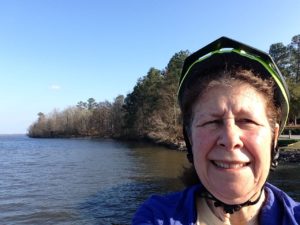
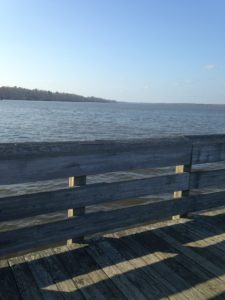
Here is a selfie at the other campsite, along with an artsie shot that I took accidentally while trying to take a selfie
There was a surprising amount of traffic, so on the return, when I saw the entrance to the off-road bicycle path, I decided to try it out, despite the “closed” sign. Although the path was both wide and flat, a lot of potholes and tree roots make it more suitable for mountain bikes. However, it beat being on the road — until almost a mile in, when the route was blocked by a large deadfall, which had taken a lot of smaller trees down with it. Given our recent kayaking experience, I decided that dragging the bike over or around the blockage was a bad idea in case the remainder of the path had additional blockages. The wisdom of this was shown the next day when we walked the trail in the opposite direction. Miles 1 -3 on the trail had multiple blockages. Walking it was possible to go over, under or around. Dragging the bike, it would have been extremely tiring.
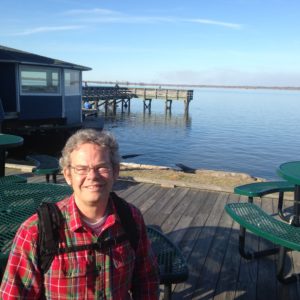 The next day was sunny but extremely windy. Kayaking was out of the question and even biking seemed iffy. We decided to walk along the lakeshore to the other campground. We soon found the other end of the bike path, and followed it instead. The photo shows Chuck at the other campground which features a fishing dock, store and wifi lounge (the latter 2 being closed during the week in the winter. We came back via the road. The entire hike took 4 hours. We are all in much better shape than we were when we started the trip, but we were still pretty tired by the time we got back to the RV.
The next day was sunny but extremely windy. Kayaking was out of the question and even biking seemed iffy. We decided to walk along the lakeshore to the other campground. We soon found the other end of the bike path, and followed it instead. The photo shows Chuck at the other campground which features a fishing dock, store and wifi lounge (the latter 2 being closed during the week in the winter. We came back via the road. The entire hike took 4 hours. We are all in much better shape than we were when we started the trip, but we were still pretty tired by the time we got back to the RV.
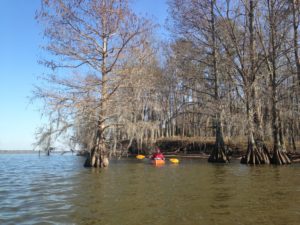 Tuesday was sunny and calm, so we were finally able to kayak. Although the original plan had been to camp in a spot where we could launch from the campsite, the trip to the other campground revealed two attractive features: a large sheltered bay and proximity to the “sunken forest” of cypress trees that had been flooded when the lake was formed, but continued to grow. Chuck felt that this forest would be a hot spot for wildlife. We loaded up the kayaks and Rumple, and headed to the launch spot.
Tuesday was sunny and calm, so we were finally able to kayak. Although the original plan had been to camp in a spot where we could launch from the campsite, the trip to the other campground revealed two attractive features: a large sheltered bay and proximity to the “sunken forest” of cypress trees that had been flooded when the lake was formed, but continued to grow. Chuck felt that this forest would be a hot spot for wildlife. We loaded up the kayaks and Rumple, and headed to the launch spot.
Once at the campground, the sunken forest did not look so close to me. Chuck checked with some people fishing off the dock, who estimated the distance to be at least 3 miles across open water. With the wind beginning to pick up, we decided that exploring the shoreline was a better bet.
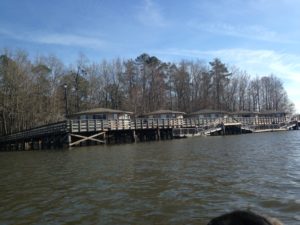 The campground has many cabins which look large and comfortable. Some are built right on the dock over the water – ideal for fishing.
The campground has many cabins which look large and comfortable. Some are built right on the dock over the water – ideal for fishing.
On this cove, most of the shore has cypress swamp for at least 10 feet into the water. There were a lot of birds and many many turtles, which slide into the water with a loud “plop” as we approached. 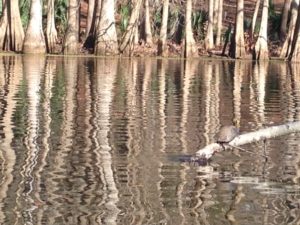 (Look on the branch coming out of the water.) Often we could see their comical heads lifted above the water as they swam. Oddly, there were also a lot of paper wasp nests hanging from the trees – mostly they seemed to be abandoned, but we did not take any chances.
(Look on the branch coming out of the water.) Often we could see their comical heads lifted above the water as they swam. Oddly, there were also a lot of paper wasp nests hanging from the trees – mostly they seemed to be abandoned, but we did not take any chances.
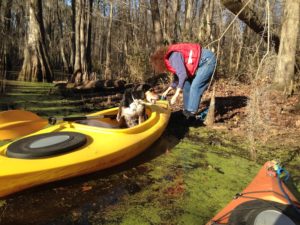 Although Rumple seemed more comfortable getting into the kayak this time, he got restless after about an hour. “Beware of alligator” signs on the shore, plus our recent experience with the mud at Congaree, discouraged us from disembarking. However, when I paddled through a patch of floating but dense duckweed, Rumple thought he saw his chance and leapt from the boat. He got the shock of his life when the apparently solid ground turned out to be water!
Although Rumple seemed more comfortable getting into the kayak this time, he got restless after about an hour. “Beware of alligator” signs on the shore, plus our recent experience with the mud at Congaree, discouraged us from disembarking. However, when I paddled through a patch of floating but dense duckweed, Rumple thought he saw his chance and leapt from the boat. He got the shock of his life when the apparently solid ground turned out to be water!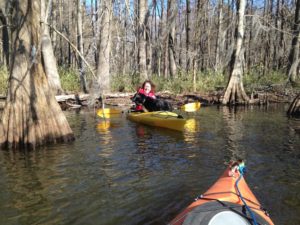 Luckily, even though at 14 1/2 he had never before been water over his ankles, his swimming instinct took over. (No picture of this – we were too busy making sure he did not drown.) Since we were unable to get him back into a kayak from the water, we guided him to shore. Then I had the unenviable task of getting him onto dry land, giving him a chance to roll around in the leaves to get some of the water and mud off, and then getting myself and a wet, muddy dog back in the kayak for the return trip. Luckily, no alligators or even wasps made an appearance (and the Lake Marion mud was less slippery than the Congaree mud). A very tired Rumple slept soundly that night.
Luckily, even though at 14 1/2 he had never before been water over his ankles, his swimming instinct took over. (No picture of this – we were too busy making sure he did not drown.) Since we were unable to get him back into a kayak from the water, we guided him to shore. Then I had the unenviable task of getting him onto dry land, giving him a chance to roll around in the leaves to get some of the water and mud off, and then getting myself and a wet, muddy dog back in the kayak for the return trip. Luckily, no alligators or even wasps made an appearance (and the Lake Marion mud was less slippery than the Congaree mud). A very tired Rumple slept soundly that night.
Our final Santee adventure occurred as we left the park in the pouring rain the next morning. We sat immobile on the road for 30 minutes as crews cleared a large tree that fell across the road. Those big deadfalls don’t just happen on bicycle paths and creeks.
